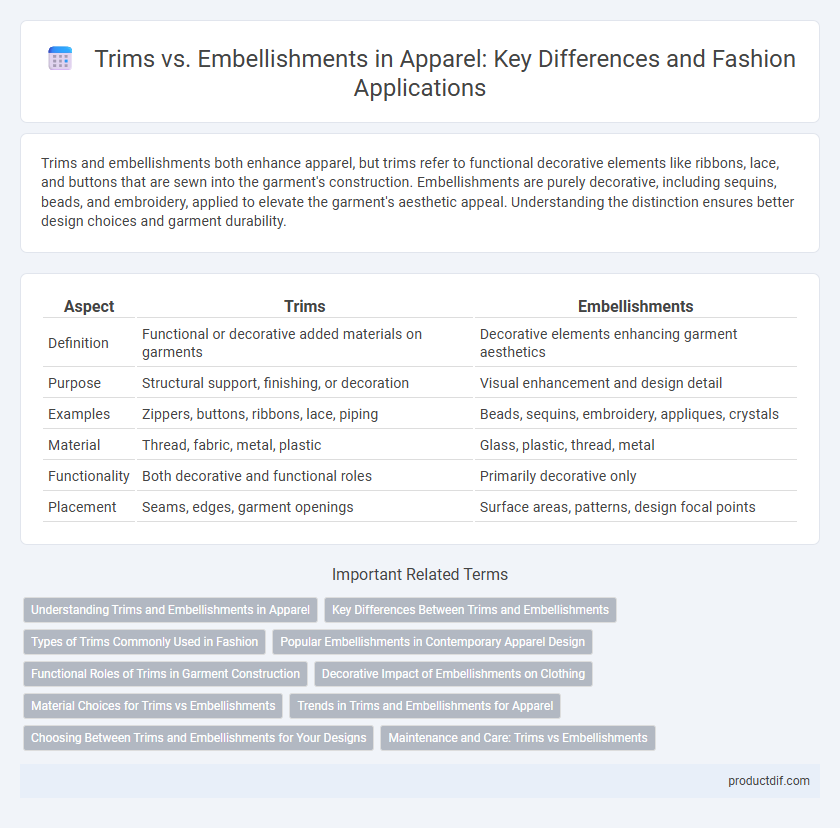Trims and embellishments both enhance apparel, but trims refer to functional decorative elements like ribbons, lace, and buttons that are sewn into the garment's construction. Embellishments are purely decorative, including sequins, beads, and embroidery, applied to elevate the garment's aesthetic appeal. Understanding the distinction ensures better design choices and garment durability.
Table of Comparison
| Aspect | Trims | Embellishments |
|---|---|---|
| Definition | Functional or decorative added materials on garments | Decorative elements enhancing garment aesthetics |
| Purpose | Structural support, finishing, or decoration | Visual enhancement and design detail |
| Examples | Zippers, buttons, ribbons, lace, piping | Beads, sequins, embroidery, appliques, crystals |
| Material | Thread, fabric, metal, plastic | Glass, plastic, thread, metal |
| Functionality | Both decorative and functional roles | Primarily decorative only |
| Placement | Seams, edges, garment openings | Surface areas, patterns, design focal points |
Understanding Trims and Embellishments in Apparel
Trims in apparel refer to functional or decorative components such as zippers, buttons, and lace that enhance the garment's structure and style. Embellishments include decorative elements like sequins, beads, and embroidery that add visual interest and texture without affecting the garment's construction. Understanding the distinction between trims and embellishments is crucial for designers aiming to balance aesthetics and functionality in clothing design.
Key Differences Between Trims and Embellishments
Trims refer to functional components like zippers, buttons, and lace that serve practical purposes in garment construction, while embellishments primarily enhance aesthetic appeal through decorative elements such as beads, sequins, and embroidery. Trims often contribute to the structure and fit of apparel, whereas embellishments focus on adding texture, color, and visual interest. Understanding these distinctions helps designers optimize both functionality and style in clothing design.
Types of Trims Commonly Used in Fashion
Common types of trims in fashion include ribbons, lace, piping, and gimp braid, which enhance garment structure and style. Buttons, zippers, and snaps serve both functional and decorative purposes, adding detail and ease of use. Braids, appliques, and fringes provide texture and visual interest, distinguishing apparel with unique finishing touches.
Popular Embellishments in Contemporary Apparel Design
Popular embellishments in contemporary apparel design include sequins, beads, embroidery, and rhinestones, enhancing garment aesthetics with texture and sparkle. These decorative elements are strategically applied to highlight design features, adding visual interest and luxury appeal. Unlike trims, which primarily serve functional purposes like finishing edges or seams, embellishments focus on ornamental value, elevating the overall style and uniqueness of the apparel.
Functional Roles of Trims in Garment Construction
Trims in apparel serve essential functional roles such as providing structural support, ensuring garment durability, and enabling size adjustments through elements like zippers, buttons, and elastic bands. They contribute to garment fit and ease of wear, enhancing the overall usability of clothing. Unlike embellishments, which primarily add decorative value, trims are integral to the construction and performance of apparel.
Decorative Impact of Embellishments on Clothing
Embellishments significantly enhance the decorative impact of clothing by adding texture, color, and visual interest through components like sequins, beads, and embroidery. Unlike trims, which mainly serve functional or finishing purposes, embellishments transform apparel into unique, eye-catching pieces that elevate style and aesthetic appeal. The strategic placement of embellishments on garments creates focal points, increasing overall garment value and consumer desirability.
Material Choices for Trims vs Embellishments
Trims typically use durable materials such as polyester, cotton, or nylon blends designed for structural purposes like seams, hems, and edges, ensuring longevity and functionality in apparel construction. Embellishments often involve more decorative materials including sequins, beads, rhinestones, and metallic threads, chosen primarily for visual appeal rather than durability. Material selection for trims prioritizes strength and flexibility, whereas embellishments emphasize texture, color, and aesthetic enhancement.
Trends in Trims and Embellishments for Apparel
Trends in apparel trims and embellishments prioritize sustainable materials and intricate designs, such as recycled metal zippers, eco-friendly buttons, and hand-sewn beadwork. Increasingly, designers incorporate 3D embroidery and laser-cut appliques to enhance texture and dimensionality in garments. Metallic accents, pastel sequins, and natural fiber tassels dominate current fashion collections, reflecting a blend of functionality and artistic expression.
Choosing Between Trims and Embellishments for Your Designs
Choosing between trims and embellishments for apparel designs depends on the desired aesthetic and functionality; trims such as zippers, buttons, and lace provide structural detail and durability, while embellishments like sequins, beads, and embroidery add decorative appeal and texture. Designers should assess the garment's purpose, target market, and production feasibility to ensure trims complement wearability and embellishments enhance visual impact without compromising comfort. Incorporating eco-friendly materials in trims and embellishments can also align designs with sustainable fashion trends.
Maintenance and Care: Trims vs Embellishments
Trims, typically made from materials like lace, ribbons, or piping, require gentle washing and often need to be hand-cleaned or spot-treated to maintain their shape and color. Embellishments such as sequins, beads, or embroidery demand delicate handling, usually necessitating low-temperature laundering or professional dry cleaning to prevent damage and preserve detail integrity. Proper maintenance extends garment longevity by safeguarding the fabric and decorative features from wear and deterioration.
Trims vs Embellishments Infographic

 productdif.com
productdif.com